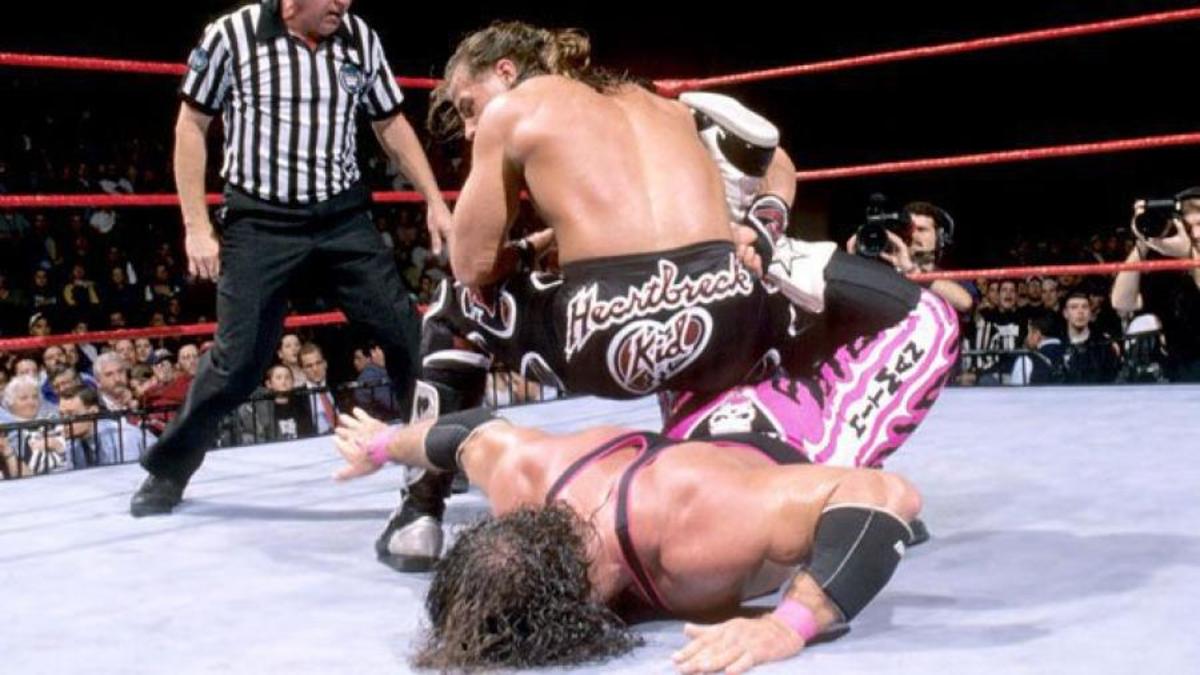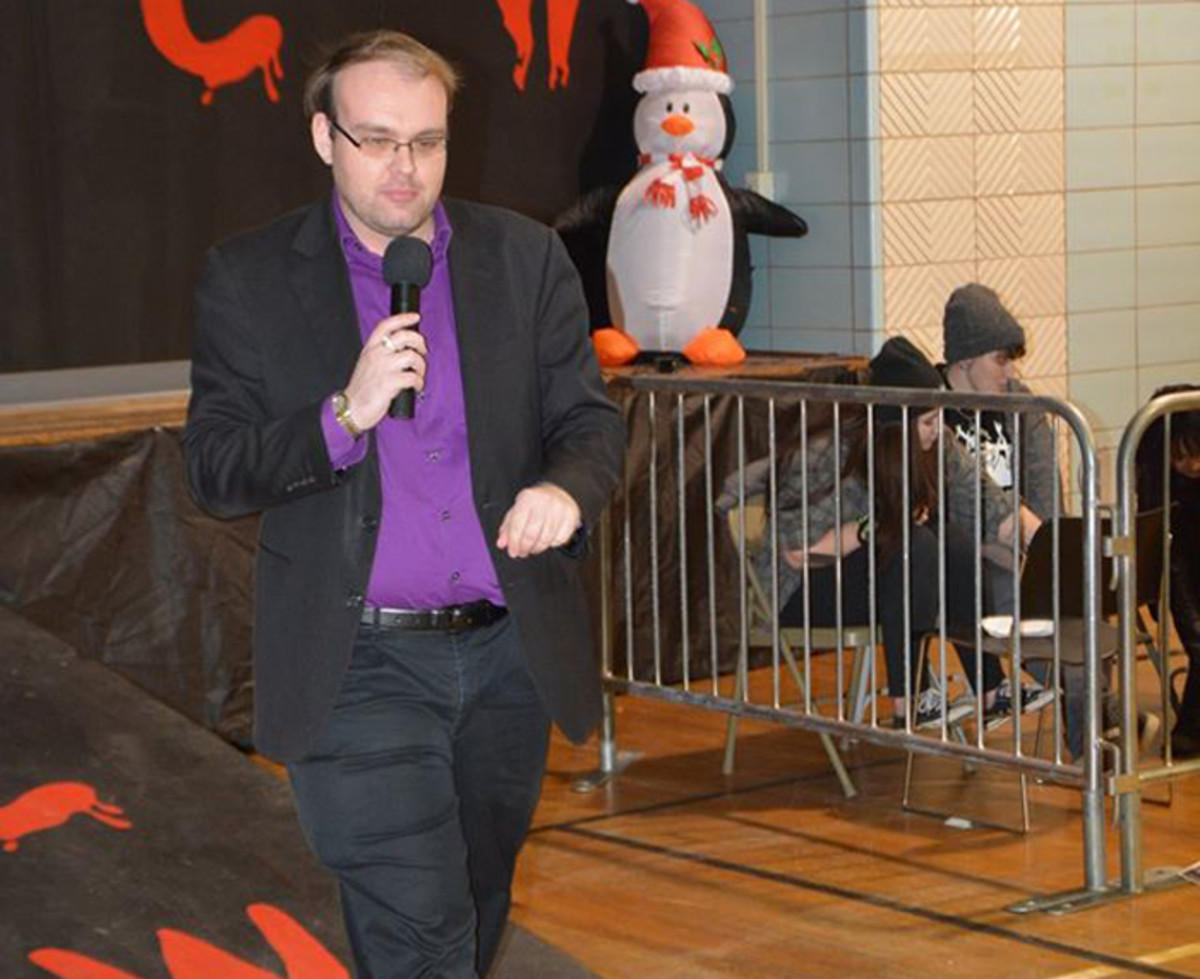The "Montreal Screwjob" is One of Pro Wrestling's Most Famous Incidents, But Was It All a Hoax?

Twenty years ago this week, one of pro wrestling’s central tenets — that it’s all scripted — was famously and fabulously ripped to shreds. The result was the strangest and realest and most controversial event in the industry’s history, one that occurred live on air, square in the middle of the ring. It culminated off-camera backstage with a wrestler blacking the eye of the company’s owner with a legitimate punch, which came after the same wrestler had hocked a loogie into said owner’s eye at ringside on camera, which was just before the wrestler threw a tantrum that included thrashing a set of video monitors used by the TV announcers. Two decades on, it is still held up as the ne plus ultra example of reality ripping pro wrestler’s theater asunder. It might be the most famous finish a match has ever had.
To understand why, let’s back up. The match was between Bret Hart and Shawn Michaels, two of the industry’s all-time greatest performers and the top two stars in the WWE (then known as the WWF) at the time. They were longtime rivals on-screen who had enjoyed a decade-long friendship off of it until the months leading up to their world championship match at the 1997 Survivor Series pay-per-view. Their relationship had soured over a variety of reasons both personal and professional, petty and justifiable. Hart had helped make Michaels a star by losing the championship to him the previous year; Michaels drew Hart’s ire by refusing to return the favor. Michaels also embodied the flamboyant, adult-oriented style of character that was sweeping wrestling, which irked the traditionalist Hart; Michaels thought Hart was a self-serious curmudgeon. As their on-screen rivalry grew that summer and fall, it began incorporating more elements of their off-screen animosity. It made for electric TV.
At the same time, Hart was on his way out the door. With the blessing of WWE honcho Vince McMahon, he had signed a contract with McMahon’s chief rival, Ted Turner’s World Championship Wrestling. Which presented a problem: Hart still held the WWE’s world championship. Before Hart began with WCW, McMahon needed a new champ. (However unlikely, McMahon feared a repeat of 1995, when his women’s champion signed with WCW, then threw her title belt in the garbage on TV.) Two further complications soon arose. First, Hart’s contract with McMahon granted creative control over his character during his final month. And second, the way McMahon wanted Hart to drop his championship was to Michaels, at the Survivor Series in Montreal.
Losing the championship — an honor and status signifier for performers even if not truly “won” — to Michaels would have been bad enough. To do it in Canada was worse. Not only were the Calgary-born Hart and his family beloved wrestling royalty in their homeland, but Bret had spent much of that year turning his patriotism into the basis of his character. In turn, Michaels had antagonized him by once sticking the Canadian flag up his nose and later draping it across the ring and humping it. When McMahon proposed Michaels beat Hart for the title in Montreal, Hart told him he’d just as soon blow his brains out. From a character standpoint, he said, that’s what he’d be doing.

After a tense week of negotiations, during which Hart proposed transitioning his championship to other performers in other cities, Hart entered the ring in Montreal having come to an agreement with McMahon: His match with Michaels would end with an indecisive disqualification, and on the next night’s episode of Monday Night Raw, Hart would make a speech and relinquish the title. But McMahon and Michaels had conspired otherwise.
Late in the planned match, when Michaels held Hart in Hart’s own signature submission hold, the referee followed McMahon’s orders to ring the bell and indicate Hart had given up. Michaels’s music played in triumph as he feigned shock and retrieved the championship belt. Hart spit in McMahon’s eye, destroyed A/V equipment, paced furiously around the ring signing “WCW” with his hands to the audience. The show ended suddenly and in confusion. No one watching was quite sure what they had seen.
The event soon gained a name: the Montreal Screwjob. Wrestling news outlets frantically reported on the buildup, execution, and fallout of the bizarre, real-life double-cross. McMahon addressed it in a character-breaking interview on Raw; Hart ranted about it when he turned up in WCW. It was chronicled in an acclaimed documentary that aired on A&E a year later, and in the decades since, WWE has produced its own documentaries on it as well. In 2015, NPR’s Radiolab even devoted an episode to the subject. The Montreal Screwjob has become one of the most storied chapters in pro wrestling lore, an endlessly dissected and debated intrusion of authenticity into the inherently reality-distorting medium.
So, 20 years later, why do some people still insist the whole thing was a fake too?
---
With the possible exceptions of reality television and magic shows, it’s hard to find entertainment with a more complex fourth-wall relationship than professional wrestling. What began as “shoot” (wrestling jargon for legitimate) competitions on the early 20th Century carnie circuit evolved into “worked” (meaning staged or pre-planned) exhibitions that enabled promoters to better wrest money from unsuspecting customers, or “marks.” Over the decades, even as wrestling grew more outrageous and companies began openly acknowledging that they were presenting a fiction-based product, “kayfabe” — the outward presentation of performances as legitimate — has largely remained intact within the performances themselves, akin to the way a Broadway actor will remain completely in character during the show, then freely mingle with fans afterwards.
In order to enjoy the show, fans have been largely happy to play along. A few years ago, SI’s Kostya Kennedy explained this by employing an apt example from the stage version of Peter Pan. When Tinker Bell is dying, Peter asks the audience to clap if they believe in fairies. Invariably, they comply with his request, despite knowing the whole thing to be imaginary. In response, Tinker Bell is revived. Everybody’s happy.
Wrestling is “a business built on a lie,” says Joe Dombrowski, an independent wrestling announcer whose credits include Ring of Honor. But “it’s a willingful lie that we all choose to believe, that we’re gonna invest ourselves into the story.”
Among Montreal Screwjob truthers, Dombrowski is the man behind their Loose Change. In 2013 he self-produced The Montreal Theory, an exhaustive, two-DVD, six-hour examination of the event culled together from video interviews with figures in and around the wrestling industry. Most have tangential connection to the event at best; some have none at all. (“I didn’t need to be in Dealey Plaza to have an opinion on what happened to JFK,” Dombrowski explains.) The two closest among those included are then-WWE announcers Kevin Kelly and Jerry “The King” Lawler, whose views differ greatly: Kelly spends most of his time dousing speculation with cold water, while Lawler — who famously worked a highly convincing segment with the comedian Andy Kaufman on Late Night with David Letterman in 1982— is shown saying he believes the Screwjob was a work.

The theory rests on the notion that all the principals came out better for it. Michaels became champion and further burnished his character’s villainous, punky credentials. McMahon got his choice of champ and the impetus to transition his character from milquetoast play-by-play announcer to the evil authority who spent the following years as the foil to rebellious anti-hero Stone Cold Steve Austin. And Hart, who had spent months provoking and alienating American wrestling audiences, suddenly became wrestling’s most sympathetic figure, a departing favor from McMahon to a longtime employee he practically considered family. The true end game would have been to set up an even bigger cash-in when Hart returned to McMahon’s company years later — plans that theorists suggest were nixed due to Hart’s concussion-forced retirement and the death of his brother in a stunt on one of McMahon’s shows. Only then, goes their story, did reality truly enter the picture.
In many ways this tinfoil-hat skepticism can be understood as a natural effect of the wrestling industry. Dave Meltzer, the longtime publisher of the Wrestling Observer Newsletter, says he remembers old-school wrestlers grumbling to him in the 1980s and ‘90s that the NFL, the NBA, and government elections were all rigged, embodying what Meltzer calls “this mentality [of], ‘If what we do isn’t real, to justify us, everything else must not be real also.’ ... You never want to be the one fooled, so even when something’s real, you think it’s not.”
A similar mindset has developed among many wrestling diehards, who yearn to be in the know despite wrestling’s endless game of three-card Monte with the truth. With the Internet age came increased glimpses behind the scenes (and equal amounts of speculation and innuendo), fostering the rise of so-called smart marks, or “smarks” — outsiders who distinguish themselves from true marks through a supposed understanding of wrestling’s machinations. (In online wrestling debates, accusations of being a “mark” are as common and versatile as their intentions are derogatory.)
For decades, when wrestling adhered more strictly to its illusion, viewers commonly looked for signs it was fake. Now that it’s admitted its fundamental truth, modern wrestling fans’ white whale is moments of reality. In either case, the aim is to be one skeptical step ahead. So it’s understandable that to self-professed “smart” fans — like to the workers themselves — there is no more embarrassing error than to get worked. Hence the vigilance toward what happened in Montreal.
Bret Hart opens up about the infamous 'Montreal Screwjob'
The Screwjob conveniently came at the dawn of this era, which presented new opportunities for the sort of multi-layered angle the conspiracy theorists suggest. The beauty of the storyline that culminated in Montreal is how, whatever real or pseudo-real elements were woven in, all of it also worked on the surface, kayfabe level. (Even within the fictional plot, McMahon screwing Hart out of the championship was not a huge departure from established character motivations.) But with the Internet helping spread info from Meltzer’s newsletter and gossipy print “dirt sheets” through the burgeoning online community, the real-life drama could be folded in as well — or, say the conspiracy theorists, invented and planted to pull the wool over even the nonbelievers. For months leading into the Survivor Series, Meltzer had been reporting on the backstage tumult between Hart and Michaels; fans in Montreal’s Molson Centre that night were informed enough that some held signs alluding to Hart’s impending departure; during the broadcast, announcers teased how unusual and tense the match would be, and that we would likely never see it again. The theory holds that all of this was part of a plan to fool everyone outside of a small circle — perhaps only McMahon and Hart — into buying the Screwjob as legit.
Watching Dombrowski’s DVD set, it can be easy to become swept up in the arguments and eerie coincidences: how Hart and Michaels admit their supposed real-life animosity the previous year had been a work that fooled even their coworkers; how Hart’s character spent the preceding months complaining on air about being “screwed” out of victories; how he had unprecedentedly shoved McMahon while blaming him for such during a scripted tirade; how an independent crew’s concurrent filming of a documentary on Hart provided a perfect vehicle to lend the supposed screwjob legitimacy. Speaking on camera, Dombrowski even brings up a piece of Meltzer’s reporting from the screwjob’s aftermath: A week before the show, McMahon had pitched Hart on a finish where Hart would be screwed out of the championship at Survivor Series, then clock McMahon with a punch on television the next night — nearly exactly what would end up happening, except that Hart’s attack occurred off-camera in the locker room, its fallout recorded only by the documentary crew. Dombrowski describes it as a possible smoking gun.
“Everything clicks, everything connects,” he tells me. “Whether they meant to or not, they told the perfect story.”
---
At this point it should be said: There are just as many reasons that the theory is almost definitely absurd. Occam’s razor, for starters. And why would McMahon, at that point losing to WCW in a bitter, all-out ratings war, put so much effort into making his competitor’s newest acquisition an even hotter commodity? There has also been simply too much scrutiny, including depositions in Hart’s family’s lawsuit against McMahon after his brother’s death, for such a massive secret to have remained hidden. If Hart and Michaels have been acting this entire time — particularly in the WWE-produced interview about their rivalry, where both fight back tears — then their talents should have catapulted them from the ring to the silver screen. (Although a skeptical viewer would love Hart’s answer when asked in that interview about why he chose to participate: “It’s a chance to expose more that what happened in the first place, that it was real.”)
Yet the theory is revealing either way. Wrestling can so distort its participants’ and fans’ relationships with reality that it can breed a sort of paranoia and distrust of those pulling the strings. If they’re lying when they pretend it’s real, might they be lying when they claim it really is?
“Some people just want to pretend they’re so smart, and by being smart they’re actually not so smart,” says Meltzer, the industry’s preeminent journalist. “I’ve had people say I was in on it and that was the key to making it work. Like, come on.”
What cannot be disputed is the Montreal Screwjob’s influence on the wrestling industry. Not only has it been exhaustively recreated by just about every company on the planet (including WWE, multiple times over), but in kick-starting McMahon’s run as a nefarious, manipulative on-screen owner, it created a storytelling archetype that his company employed time and time again, through the present day. Evil bosses Stephanie McMahon and evil Triple H running all of WWE, evil boss Vickie Guerrero running Smackdown, evil boss John Laurinaitis running Raw, evil boss Eric Bischoff running Raw — it all began that night in Montreal. Less successfully, the Screwjob’s shattering of the fourth wall has also been duplicated ad nauseam, often misguidedly and to the point of diminishing returns. WCW ended up attempting so many so-called “worked shoots” that when the company was folding in 2001, some wrestlers earnestly told Meltzer it was just their bosses trying to pull off another edgy angle.
WWE has generally treaded lightly in worked-shoot territory. Perhaps the most prominent example was in 2011, when CM Punk closed an episode of Raw with a rant laced with insider references, only to have his mic cut off when he began to disparage McMahon. Afterwards the Internet went into a tizzy over whether Punk had veered off script, generating exactly the type of heightened interest WWE had hoped. Similar reactions followed microphone jabbing between John Cena and the Rock the next year and, most recently, an almost entirely meta-level exchange of verbal barbs between Cena and Roman Reigns this fall. That all of these proved to have been complete works is beside the point. Fans felt like they might have seen through what was being presented — a thrill in itself.
Which is perhaps why Dombroski says his Montreal Theory is easily his most successful production to date, with “hundreds and hundreds” of copies sold despite only rudimentary grassroots promotion. Feedback within the industry has been predictably divided. (Hart’s ex-wife Julie has called it “the most ridiculous thing I’ve ever heard.”) But Dombrowski, who cites Penn Jillette and wrestler-turned-governor-turned-conspiracy-theorist Jesse Ventura as influences, defends the endeavor as one based in worthwhile curiosity. “The biggest shocker and the biggest screw job in wrestling history happens and we’re taking everybody at face value?” he says. “How does that happen? What’s wrong with asking questions?”
As for whether he himself believes, Dombrowski is noncommittal. “My opinion changed by the week, and it changed by what chapter I was editing,” he says of his wavering during the three-year production process. “Some things clicked better than others. I’m on the fence. If you ask me on a given week, I’ll tell you, I’m 51 and 49 on the percentage break if Bret knew or not.”
John Hennigan to Make His MLW Debut at Never Say Never
As I drove home from our conversation — northbound on a mostly empty New Jersey Turnpike, sometime between 2 and 3 a.m., an easy place to pretzel one’s mind — another remark of Dombrowski’s bounced off the ropes in my head: “Maybe I’m working you, about the shoot I made about the shoot being a work.” Maybe he was. I felt confused. I felt exhausted. I felt like a mark.
It can be a common feeling these days. Look around. Constant cries of “fake news.” Two political parties each seizing on the other’s alleged collusion. This century’s second controversial presidential election. An increasingly powerful class of elites; stagnated wages for everyone else. Major legislation written in secret. Speculation that a pro sports league had conspired to exclude a protesting player. Distrust abounds. It can be hard to get anyone to agree on what’s real.
Dombrowski would concur. “It’s not a danger to the world that Vince McMahon is keeping the truth about Montreal from us,” he says. “But there’s a lot of Vince McMahon-like people in the quote-unquote ‘real world’ that are keeping a lot worse stuff from us, and we should hold their feet to the fire.”
No wonder people question what happened in Montreal. What good does trust get you? In a world where everything can seem like a work, it’s better to be skeptical than screwed.
